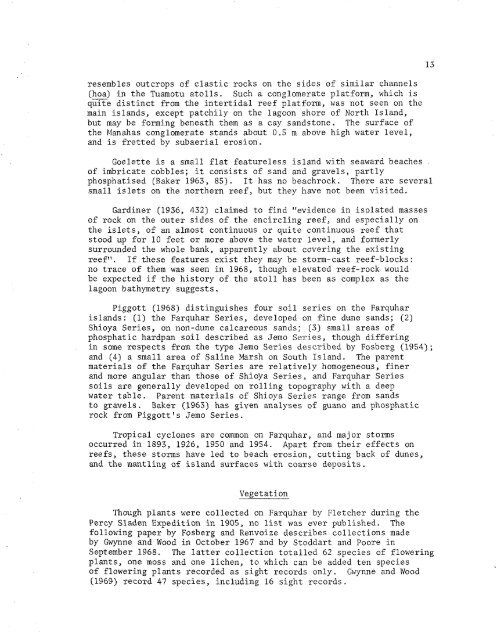ATOLL RESEARCH BULLETIN - Smithsonian Institution
ATOLL RESEARCH BULLETIN - Smithsonian Institution
ATOLL RESEARCH BULLETIN - Smithsonian Institution
Create successful ePaper yourself
Turn your PDF publications into a flip-book with our unique Google optimized e-Paper software.
esembles outcrops of clastic rocks on the sides of similar channels<br />
(hoa) - in the Tuamotu atolls. Such a conglomerate platform, which is<br />
quite distinct from the intertidal reef platform, was not seen on the<br />
main islands, except patchily on the lagoon shore of North Island,<br />
but may be forming beneath them as a cay sandstone. The surface of<br />
the Manahas conglomerate stands about 0.5 m above high water level,<br />
and is fretted by subaerial erosion.<br />
Goelette is a small flat featureless island with seaward beaches<br />
of imbricate cobbles; it consists of sand and gravels, partly<br />
phosphatised (Baker 1963, 85). It has no beachrock. There are several<br />
small islets on the northern reef, but they have not been visited.<br />
Gardiner (1936, 432) claimed to find "evidence in isolated masses<br />
of rock on the outer sides of the encircling reef, and especially on<br />
the islets, of an almost continuous or quite continuous reef that<br />
stood up for 10 feet or more above the water level, and formerly<br />
surrounded the whole bank, apparently about covering the existing<br />
reef". If these features exist they may be storm-cast reef-blocks:<br />
no trace of them was seen in 1968, though elevated reef-rock. would<br />
be expected if the history of the atoll has been as complex as the<br />
lagoon bathymetry suggests.<br />
Piggott (1968) distinguishes four soil series on the Farquhar<br />
islands: (1) the Farquhar Series, developed on fine dune sands; (2)<br />
Shioya Series, on non-dune calcareous sands; (3) small areas of<br />
phosphatic hardpan soil described as Jemo Series, though differing<br />
in some respects from the type Jemo Series described by Fosberg (1954);<br />
and (4) a small area of Saline Marsh on South Island. The parent<br />
materials of the Farquhar Series are relatively homogeneous, finer<br />
and more angular than those of Shioya Series, and Farquhar Series<br />
soils are generally developed on rolling topography with a deep<br />
water table. Parent materials of Shioya Series range from sands<br />
to gravels. Baker (1963) has given analyses of guano and phosphatic<br />
rock from Piggott's Jemo Series.<br />
Tropical cyclones are common on Farquhar, and major storms<br />
occurred in 1893, 1926, 1950 and 1954. Apart from their effects on<br />
reefs, these storms have led to beach erosion, cutting back of dunes,<br />
and the mantling of island surfaces with coarse deposits.<br />
Vegetation<br />
Though plants were collected on Farquhar by Fletcher during the<br />
Percy Sladen Expedition in 1905, no list was ever published. The<br />
following paper by Fosberg and Renvoize describes collections made<br />
by Gwynne and Wood in October 1967 and by Stoddart and Poore in<br />
September 1968. The latter collection totalled 62 species of flowering<br />
plants, one moss and one lichen, to which can be added ten species<br />
of flowering plants recorded as sight records only. Gwynne and Wood<br />
(1969) record 47 species, including 16 sight records.

















